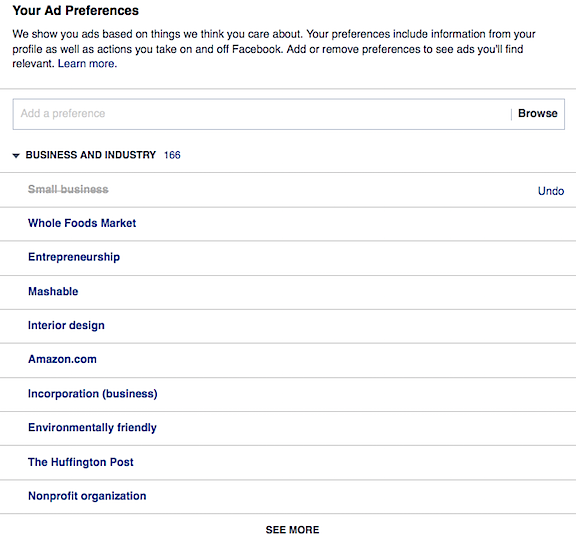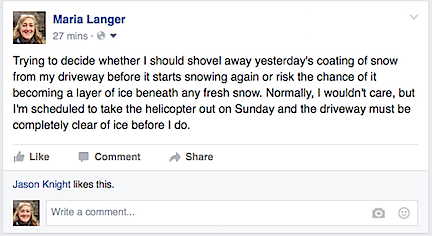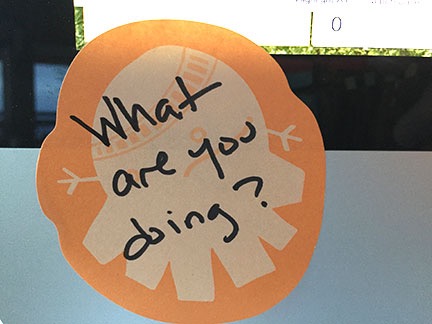A few thoughts.
In recent months, I’ve found Twitter a lot more pleasant than Facebook for social networking. When I mention this to friends, they tell me that they don’t understand why. They say that they just don’t “get” Twitter.
I’ve given this a lot of thought, trying to understand why so I can explain it to others. This is what I’ve come up with.
The people I’m friends with on Facebook are, for the most part, real friends — people I know in real (vs virtual) life. They’re people I like and want to respect. When I see them posting idiotic, shortsighted, uninformed, or just plain stupid things, it hurts and confuses me. I like these people and I want to think they’re relatively smart or can listen to reason or aren’t the hateful, brainwashed idiots they seem to be. But over and over again, they share thoughtless, tasteless crap and downright lies, much of it parroted from a dubious “news” sources. I hate to think that the people I really like subscribe to such bullshit.
Obviously, this isn’t all of my Facebook friends. But it is a lot of them. More than I care to admit.
Yes, it’s easy enough to get the stuff I don’t want to see off my timeline:
- If they’re real friends I can simply unfollow their updates. Then we can remain Facebook (and real) friends but I don’t have to be reminded periodically about their political or intellectual shortcomings. They probably don’t even realize that I’ve unfollowed them! (No harm, no foul.) And it’s easy enough to start following them again hen they’ve stopped posting the kind of crap that I don’t want to see.
- If they’re not real life friends, I can unfriend them. They’ll continue to see and respond to my public updates, but nothing else. I won’t see anything they post unless it’s a response to me or someone I follow. In November and December, I unfriended about 100 people I really didn’t know or care about. I also turn down almost every single new friend request.
- If they’re people who I don’t even know who insist on posting crap on the updates of my other friends or even my own public updates, I can block them. I have blocked dozens of people on Facebook, including more than a few people who were once “friends” and even at least one family member.
But what I’m left with on Facebook is very little of interest to keep me there and the feeling that I have to walk on eggshells with every single thing I post.
Now combine that with Facebook’s algorithms that determine what I see and the order in which I see it and and the endless regurgitated posts about what happened a year ago or two years ago or five years ago and the reminders of birthdays and holidays and the suggestions about what I should share based on what’s in my clipboard and the tracking of my activity all over the web so it can display ads that I might click on — well, does any of that would like something I might like?
Is visiting Facebook a pleasant experience? Not usually. It’s mostly a frustrating waste of time.
Twitter isn’t like this at all.
Most of the accounts I follow on Twitter are people and organizations I don’t know in real life. The real friends I have there are people I’ve met on Twitter and have formed connections with based on real social networking interactions there. They are, for the most part, thinkers and doers — people and organizations I like and can respect based on the things they say and share in their tweets.
What do they tweet? Comments, news stories, images, jokes, and videos, all of which interest me in one way or another. They are tech people and artists, journalists and programmers, writers and photographers. They are publications and broadcasters and government agencies. There are only 206 of them (today) and it isn’t likely that there will be many more. I prune the list of accounts I follow on a regular basis, weeding out the ones that tweet things I don’t want to see and adding ones I think I might enjoy.
I read the tweets in my newsfeed regularly to keep up with them. I often read or at least glance at the articles they link to. These things help me learn more about what’s going on in the world. They help inform my opinions. They help me understand what’s important.
And I tweet what’s on my mind. I link to articles and videos. I share (or retweet) some of the tweets the people I follow have shared.
And I respond to some of the tweets I read. I agree or disagree. I compliment or criticize. I interact with more effort than simply clicking a “Like” button. I expand my world, form new relationships, share viewpoints.
If another person I don’t know or care about rudely or crudely attacks me in response to something I’ve tweeted or shared, I block him or her. It’s as simple as that. I’m not going to waste my time dealing with small minded, petty people. Life’s too short to deal with trolls and cyber bullies. It’s no secret that Internet trolls engage in such behavior because they have little else in their lives to keep them busy.
And Twitter doesn’t play games with me. It displays every single tweet by every single person I follow in the order in which it was tweeted. There are no algorithms determining what I see on Twitter, no suggestions on what to tweet, and no reminders of what I or the people I followed tweeted in the past.
Twitter treats me like an adult and gives me instant access to the things that interesting people and organizations are sharing right now. There’s always something new to see and learn on Twitter. There’s always someone interacting with me and my tweets. There’s always something interesting for me to read or watch or learn or share.
The Bubble
I hear it already: naysayers telling me that I’m in a bubble.
Okay. So what? Don’t I have a right to filter out bullshit and focus on the things that can entertain me or make me smarter? News stories or opinions based in truth that aren’t full of hateful rhetoric?
Just as my Facebook friends have the right to share what Alex Jones or Mother Jones says, I have the right to ignore them and focus on the work of investigative journalists reporting for reliable news sources. I have the right to ignore Fox News or MSNBC pundits in favor of fact-based opinion pieces that appeal to my mind instead of my emotions. Information sources that make me want to act because I want to do the right thing instead of because I’m spurred to hate someone or something for no good reason.
Anyway, that’s my reasoning.
You can find me on Twitter at @mlanger. Over 2,000 other people already have.







